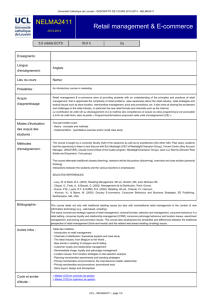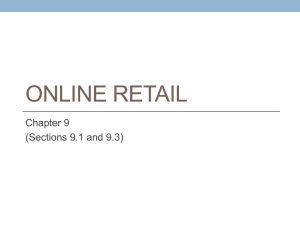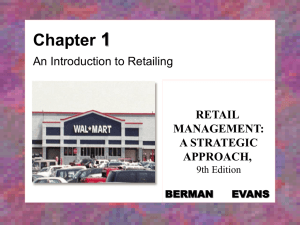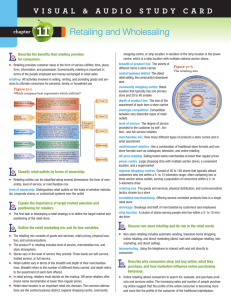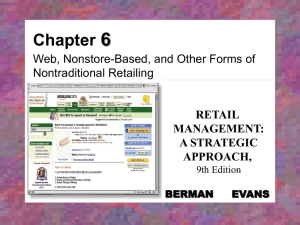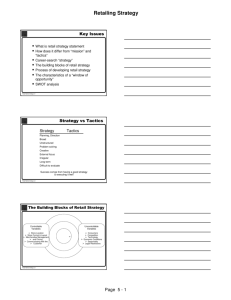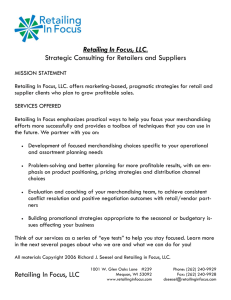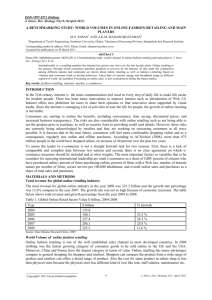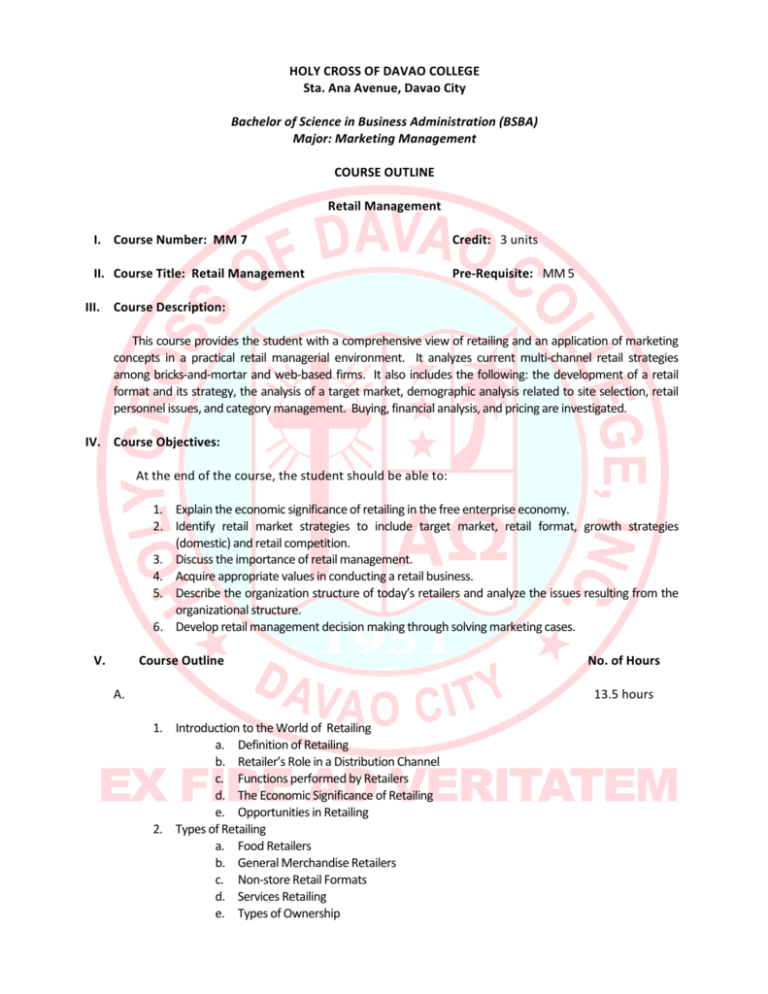
HOLY CROSS OF DAVAO COLLEGE Sta. Ana Avenue, Davao City Bachelor of Science in Business Administration (BSBA) Major: Marketing Management COURSE OUTLINE Retail Management I. Course Number: MM 7 Credit: 3 units II. Course Title: Retail Management Pre-­‐Requisite: MM 5 III. Course Description: This course provides the student with a comprehensive view of retailing and an application of marketing concepts in a practical retail managerial environment. It analyzes current multi-­‐channel retail strategies among bricks-­‐and-­‐mortar and web-­‐based firms. It also includes the following: the development of a retail format and its strategy, the analysis of a target market, demographic analysis related to site selection, retail personnel issues, and category management. Buying, financial analysis, and pricing are investigated. IV. Course Objectives: At the end of the course, the student should be able to: 1. Explain the economic significance of retailing in the free enterprise economy. 2. Identify retail market strategies to include target market, retail format, growth strategies (domestic) and retail competition. 3. Discuss the importance of retail management. 4. Acquire appropriate values in conducting a retail business. 5. Describe the organization structure of today’s retailers and analyze the issues resulting from the organizational structure. 6. Develop retail management decision making through solving marketing cases. V.
Course Outline No. of Hours A. 13.5 hours 1. Introduction to the World of Retailing a. Definition of Retailing b. Retailer’s Role in a Distribution Channel c. Functions performed by Retailers d. The Economic Significance of Retailing e. Opportunities in Retailing 2. Types of Retailing a. Food Retailers b. General Merchandise Retailers c. Non-­‐store Retail Formats d. Services Retailing e. Types of Ownership 3. Trends in Retailing a. The Emergence of the Worldwide Web and other Forms of Nontraditional Retailing a.1. The Role of the Web a.2. The Scope of Web Retailing a.3. Characteristics of Web Users a.4. Factors to Consider to have a Website a.5. Examples of Web Retailing in Action a.6. Other Nontraditional Forms of Retailing B. No. of Hours 13.5 hours 13.5 hours C. 1. Identifying and Understanding Consumers a. Demographic of Retail Consumers b. How Consumers Make Decisions 2. Developing a Retailing Strategy a. Place Strategy b. Product Strategy c. Price Strategy d. Advertising Strategy e. Selling Strategy f. Promotion Strategy g. Ethics and Legal Issues in Retailing 3. Customer Service a. Strategic Advantage through Customer Service b. Customer Evaluation of Service Quality c. The Gaps Model for Improving Retail Service Quality d. Service Recovery 4. Ethical & Legal Issues in Retailing a. Government Regulations b. Legal Considerations on Environmental Issues, Zoning and Building codes, signs and Licensing Requirements c. Consumer Fraud d. Supplier Labor Practices e. Retail Theft f. Slotting Allowances g. Use of Customer Information h. Ecological Considerations i. Legal and Fin. Responsibilities j. Trading Area Analysis k. Site Selection 1. Developing and Implementing Merchandise Plans a. Buying Organization Formats and Processes b. Devising Merchandise Plans c. Implementing Merchandise Plans d. Logistics e. Inventory Management 2. Financial Merchandise Management a. Inventory Valuation: The Cost and Retail Method b. Unit Control Systems c. Fin. Inventory Control Integrating Dollar & Unit Concepts D. VI.
1. Store Layout, Design and Visual Merchandising a. Objectives of a Good Store Design b. Store Layout c. Space Planning d. Merchandise Presentation Techniques e. Atmospherics 13.5 hours References A. Bibliography Bearden, Ingram & La Forge (2007). Marketing Principles and Perspectives. 5th Edition.
McGraw-Hill International Edition.
Etzel, Stanton & Walker (2007). Marketing. 14th Edition. McGraw-Hill/Irwin.
Kotler & Armstrong (2008) Principles of Marketing, Pearson Prentice Hall.
Kotler & Armstrong (2010). Principles of Marketing – Global Edition, Pearson Prentice Hall.
Kurtz & Boone (2010). Principles of Contemporary Marketing, Southern-Western.
Lovelock & Wirtz (2007). Services Marketing, Pearson Prentice Hall.
Peter & Donnelly, Jr. (2009). Marketing Management, McGraw-Hill Irwin.
Sidphuria, Manish (2010) Retail Franchising, McGraw-Hill International Edition.
Stevenson (2007). Operations Management, McGraw-Hill Irwin.
Young & Pagoso (2008) Principles of Marketing, Rex Book Store, Inc.
B. Webliography
Retailing. Retrieved on December 3, 2007 from http://www.knowthis.com/tutorials/principlesof-marketing/retailing/6.htm
Retailing
Strategy
from
comde.nsf/vwapj/chapter1.pdf/$FILE/chapter1.pdf
http://www.ic.gc.ca/epic/site/retra-
VII.
Course Requirements A.
B.
C.
D.
E.
VIII.
Quizzes Classroom Presentations Written Analysis Of Case Study Periodical Examinations Presentation Of A Retail Store Concept Paper Grading System Midterm Grade Tentative Final Grade Prelim Examination 25% Semi-­‐final Examination 25% Midterm Examination 25% Final Examination 25% Class Standing 50% Class Standing 50% Total 100% Total 100% Midterm Grade + Tentative Final Grade Final Grade = 2



